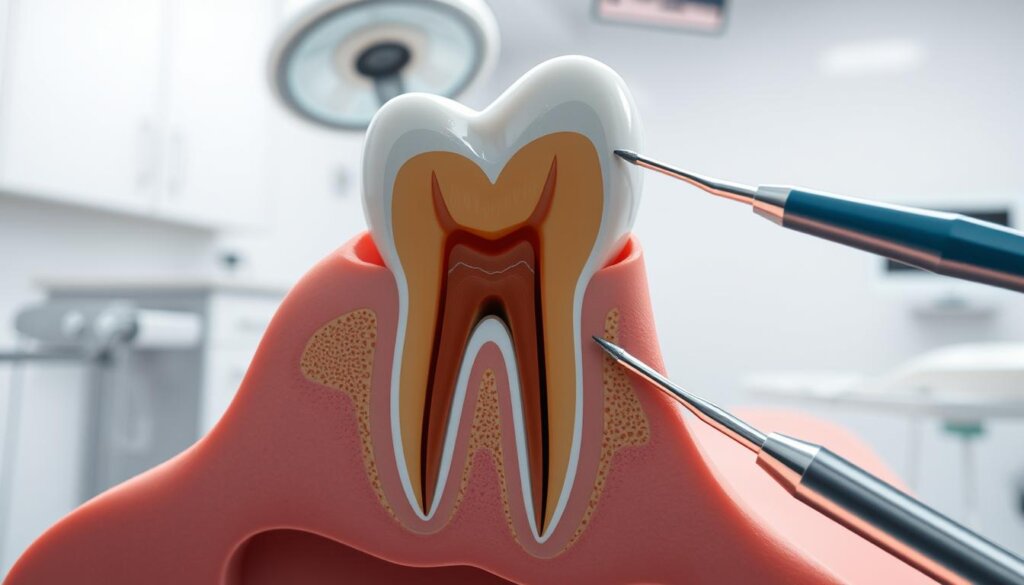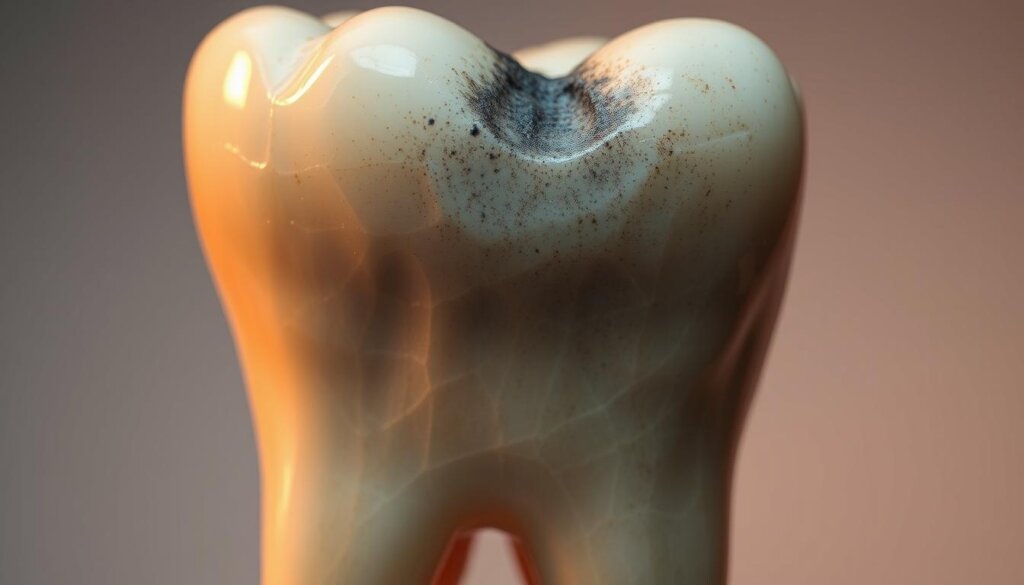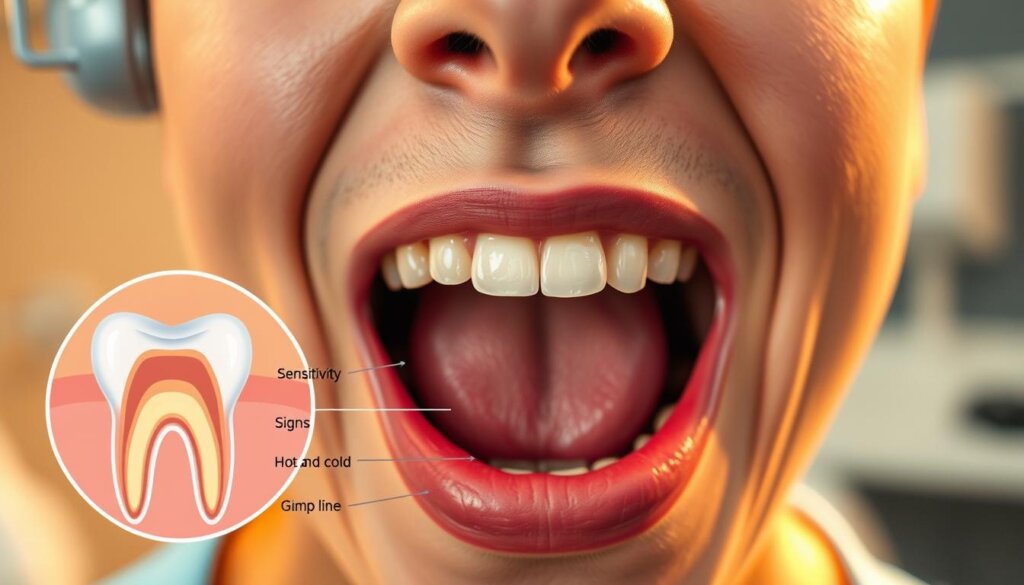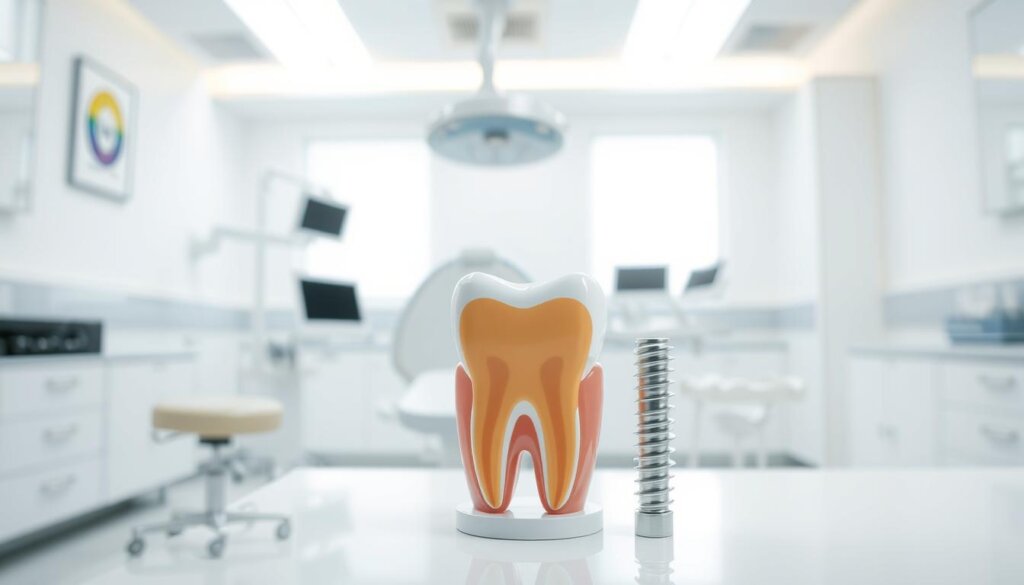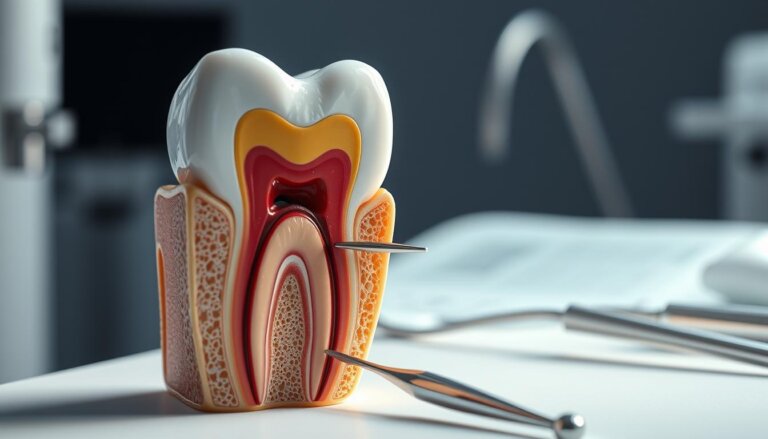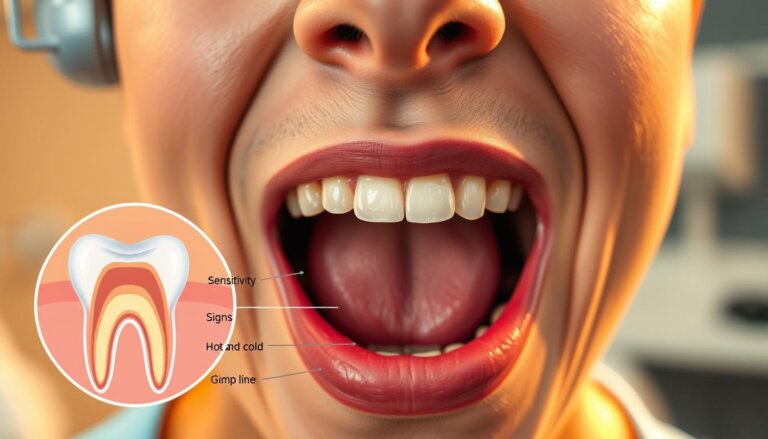Will the Tooth be “Dead” After a Root Canal, and is That Okay?
Every year, over 15 million people in the U.S. get root canal treatments. This makes many wonder if the tooth becomes “dead” after the pulp is removed. Even without nerves and blood, the tooth can work well if sealed and cared for.
People often ask if a tooth without a living pulp is safe. Studies show that a fixed tooth can handle daily chewing. It just needs regular care and check-ups to stay healthy and infection-free.
Key Takeaways
- A tooth without living pulp can serve as a chewing surface.
- Sealing the tooth is key to keep bacteria out.
- Dental experts suggest crowns or fillings for extra protection.
- Regular dental visits help catch problems early.
- Good oral hygiene helps keep the treated tooth healthy for years.
Understanding Root Canals
Root canals clean and save the inside of a tooth when decay or infection hits the pulp. This helps keep your mouth healthy for a long time. It also stops pain and protects the surrounding tissues.
What is a Root Canal?
This dental treatment removes infected pulp deep in a tooth. A dentist then seals the chamber to stop bacteria growth. The tooth is then fixed with a strong restoration.
The Procedure Explained
An X-ray check finds any damage or swelling. A small hole is made, and the infected pulp is carefully removed. After cleaning, the canals are filled with a safe material. Then, the tooth is sealed.
Common Reasons for Root Canals
Many people get root canals for these reasons:
- Deep cavities and severe tooth decay
- Cracked or fractured enamel exposing the pulp
- Persistent abscesses causing pain or swelling
The Concept of a “Dead” Tooth
A tooth without living pulp often sparks curiosity. Dental professionals, researchers, and patients find it interesting. It may seem strange to think of a tooth as “dead,” yet the enamel and dentin can stay functional for a long time.
Many wonder if a pulp-free tooth can work. We aim to explain why a tooth without blood vessels and nerves doesn’t mean it’s useless. This topic sheds light on how modern dentistry keeps smiles healthy, even after damage.
What Does “Dead” Mean in Dental Terms?
A “dead” tooth has no vital pulp. It doesn’t react to hot or cold anymore. Dentists check for blood flow and nerve function to see if a tooth is non-vital. Even without these, the outer layers stay strong and keep their shape.
How a Tooth Becomes Non-Vital
Several factors can lead to pulp loss, including:
- Deep decay that allows bacteria to invade the pulp
- Trauma causing irreversible nerve damage
- Advanced gum issues that spread below the enamel
When pulp tissue dies, no pain signals are sent. This change in structure is why it’s called “dead.” Yet, with the right care, it can support biting and chewing.
Is a Dead Tooth Safe?
A non-vital tooth can stay functional with proper care. Experts, like the American Dental Association, say a tooth treated with a root canal can be safe. This method removes infected tissue and seals the tooth inside.
Risks Associated with Non-Vital Teeth
Non-vital teeth can face risks like bacterial growth. If decay is not treated, it can cause bigger problems. Spotting early signs can help avoid sudden pain or infection.
- Possible abscess formation beneath the tooth
- Structural damage if decay spreads
Benefits of Retaining a Dead Tooth
Keeping a non-vital tooth through endodontic therapy is beneficial. It helps maintain oral balance. Saving the natural tooth supports chewing and protects other teeth from moving.
- Preservation of normal bite alignment
- Maintained appearance and function
Signs You May Need a Root Canal
Persistent pain in your mouth could mean a bigger issue. Sensitive teeth might start with small twinges but grow into sharp pains. This could make you wonder if a root canal is needed to save your tooth.
Everyone shows signs differently. Your gums might look swollen or have bumps. If hot or cold makes your tooth hurt, it could be a sign of infection inside the tooth.
Tooth Pain and Sensitivity
A dull ache can turn into sharp pains when you eat or drink something hot or cold. An intense throbbing that spreads to your jaw is a clear sign you need help fast.
Swelling and Discoloration
Swollen tissue near your tooth base means inflammation is ongoing. If your tooth looks gray or dark, it could be damaged inside. A root canal might be needed to fix this and save your tooth.
| Indicator | Reason for Concern |
|---|---|
| Lingering Sensitivity | Pulp irritation |
| Gum Swelling | Possible infection |
| Dark Tooth Shade | Nerve damage |
Post-Procedure Expectations
Many people feel relieved after a root canal is done. Anesthetics help with pain during the procedure. But, some tenderness might stay for a bit. Most dentists say you can go back to normal activities soon, making you feel more confident in your tooth.
Healing Timeline After a Root Canal
The area around the tooth might feel sore for a little while. The American Dental Association says some swelling is normal and goes away in a few days. Everyone heals differently, but most people start to feel better over time. Regular check-ups make sure the tooth is sealed and safe from infection.
Dental teams suggest:
- Gentle brushing to avoid irritation
- Using over-the-counter pain meds if a dentist says it’s okay
- Regular check-ups to watch how you’re healing
Common Symptoms Post-Procedure
You might feel some sensitivity to cold or pressure, but it usually goes away fast. The gum might get a bit red or sore from the treatment. If these symptoms don’t go away, see a dentist right away. This ensures your tooth stays healthy and works well after the root canal.
Treatment Options for a “Dead” Tooth
A non-vital tooth often gets weaker after the pulp is gone. Dentists use methods to keep it strong and looking natural. They aim to keep as much of the tooth as possible and give patients a strong result.
Crowning a Root Canaled Tooth
Putting a crown on the tooth helps it stay strong. Dentists use materials like porcelain or ceramic that look and feel like the real thing. This helps prevent the tooth from breaking down.
Crowns can be made to match the color and shape of your other teeth. They are durable and help you chew food without problems. To put on a crown, the dentist smooths the tooth and adds a protective cap.
Alternatives to Root Canals
Some people might choose to have the tooth pulled and replaced with an implant or bridge. Pulling the tooth might be a good option if it’s too damaged or if there’s not enough bone left. An implant acts like a new root and can last a long time.
Bridges use the teeth next to the empty space to support them. They help keep your bite even. When deciding, think about your current dental health, budget, and what you prefer.
| Treatment | Main Advantage |
|---|---|
| Crown After Root Canal | Preserves tooth structure and appearance |
| Tooth Extraction & Implant | Replaces the lost tooth root with stability |
| Tooth Extraction & Bridge | Fills the gap by using adjacent teeth for support |
Lifestyle Adjustments After a Root Canal
Many people find it helpful to slowly get back to eating regular meals once the treated area feels better. Choosing gentle foods can help with comfort and healing.
Dietary Recommendations
Starting with softer foods that don’t need much chewing is a good idea. Try blended soups, pureed fruits, and mashed veggies. They put less pressure on the tooth. Adding small amounts of lean proteins like fish or tofu can help keep your diet balanced.
| Food | Why It’s Beneficial |
|---|---|
| Mashed Vegetables | Easy on teeth and high in vitamins |
| Pureed Soups | Comforting and gentle for healing |
| Yogurt | Offers calcium without heavy chewing |
Oral Hygiene Tips
Brushing regularly with a soft-bristled brush is key to protecting the restored tooth. Don’t forget to floss between the treated areas to control plaque. Using specialized rinses, like chlorhexidine solutions, can also help fight bacteria. This keeps the tooth stable and improves long-term health.
Importance of Regular Check-Ups
Going to the dentist regularly is key to keeping your smile healthy after a root canal. These visits help catch small changes that could affect your tooth. It’s good to spot gum inflammation or damage early.
How Often Should You See Your Dentist?
Seeing your dentist every six months is common. But, some people might need to go more often. Each visit helps keep an eye out for problems before they start.
They might suggest more visits for people with complex health issues.
What to Discuss During Check-Ups
Ask about any pain, swelling, or sensitivity during your visit. Dentists check how your tooth fits and how your bite feels. They look for any signs of problems.
Non-vital tooth health is very important. Finding issues early helps your tooth work better. Tell your dentist about any new medicines or changes in what you eat.
- Share any change in oral hygiene habits
- Note concerns about discoloration or biting pressure
- Track ongoing comfort levels
Return to Normal Activities
Most people can start doing light tasks soon after a root canal. You might feel a bit sore, but over-the-counter pain meds can help. This way, you heal faster and avoid putting too much pressure on the treated tooth.
Timeline for Resuming Normal Activities
Take it easy for the first day to see if any numbness goes away. Simple tasks and office work are usually okay after 24 hours. But, wait a bit longer for activities that are too strenuous or require lifting heavy things.
Do’s and Don’ts After the Procedure
Here are some tips to help your tooth heal:
- Do stick to softer foods when tenderness is present
- Do monitor your comfort level and rest if aches persist
- Don’t chew on hard items while the area is numb
- Don’t consume extremely hot or cold beverages in the first few days
Following these tips helps your healing and gets you back to normal faster.
Long-Term Care for a Root Canal Tooth
Keeping a restored tooth safe needs careful habits and regular checks. Each step helps keep the tooth healthy and lowers the chance of problems.
Avoiding Complications
Regular visits to the dentist help catch issues early. Grinding, decay, or old fillings can harm a treated tooth. To avoid problems, patients should:
- Use a night guard if grinding persists
- Avoid eating hard things like ice cubes
- Clean around the crown carefully
How to Maintain Tooth Structure
Strengthening enamel can help a root canal tooth. Many use products to make teeth stronger. Regular dental exams and cleanings catch small problems early. Good daily habits help prevent tooth damage and infection, keeping you comfortable while eating for years.
Psychological Impact of a “Dead” Tooth
Learning your tooth is non-vital can be unsettling. It may affect how you see yourself. But, experts say a treated tooth can stay strong and work well.
Trust in endodontic therapy can help you feel better. It helps many people get past their worries.
Addressing Concerns and Fears
Some worry a “dead tooth” means they’re not healthy. Talking to a dentist can help. A root canal removes infection but keeps the tooth’s natural shape.
This makes the tooth comfortable for a long time. Sharing your fears can make you feel more confident. It encourages you to take steps to feel better.
Understanding the Aesthetic Implications
Damage can cause a tooth to look different. This might make you feel less confident. But, there are ways to fix this.
Things like bleaching or veneers can make your tooth look great again. Seeing how these solutions work can make you feel better.
- Open dialogue: Helps clarify treatment goals
- Support networks: Connects patients with valuable resources
| Strategy | Benefit |
|---|---|
| Dental Counseling | Reduces anxiety and boosts awareness |
| Cosmetic Restorations | Improves alignment, color, and confidence |
When to Seek Further Treatment
After a root canal, some people might face unexpected problems. If you keep feeling pain or discomfort, it could mean something serious. Regular dental visits can catch issues early, but some signs need quick action.
Signs of Infection
Signs of infection after a root canal include sharp pain, swollen gums, or fluid around the tooth. If your crown feels loose or your tooth hurts more, it might be infected. Catching this early can help save your tooth.
When to Consider Extraction
If your tooth is badly damaged and can’t be fixed, it might need to be pulled. Dentists look at a few things to decide:
- How often you feel deep pain
- How much bone is lost around the tooth
- How big the cracks in your tooth are
But sometimes, you might need to remove the tooth to keep your mouth healthy. This is safer if infection is a big risk.
| Symptom | Potential Complication | Recommended Action |
|---|---|---|
| Persistent soreness | Ongoing reinfection | Root canal revision |
| Swollen gums | Abscess formation | Immediate evaluation |
| Weak tooth structure | Risk of fracture | Possible extraction |
Comparison with Other Dental Procedures
Choosing dental care means looking at different options. Some choose to remove the tooth to stop infection. Others prefer to keep the tooth and fix it instead. Each choice affects your health and comfort over time.
Root Canal vs. Extraction
Root canal therapy cleans the inside of a damaged tooth. It removes bacteria and keeps the tooth’s outer part. Extraction, on the other hand, removes the whole tooth.
This can cause other teeth to shift and bone loss in the jaw. It might make future dental work harder because the teeth’s alignment can change. Many dentists think root canals are better because they help keep your bite and smile natural.
Cost Considerations for Treatments
Some think pulling a tooth is cheaper upfront. But is it really more affordable in the long run? After pulling a tooth, you might need implants or bridges, which can cost more.
Root canals can save you money by avoiding these extra costs. The price depends on where the tooth is, if you need sedation, and what materials are used for the final fix. It’s smart to think about all these factors before deciding.
Patient Testimonials and Experiences
Many people have found relief and normal chewing after root canal therapy. The American Dental Association has collected many stories. These stories show less pain and better oral health.
Success Stories After Root Canals
Patients feel more comfortable thanks to new anesthesia and clear talks before surgery. Some feel more confident in social situations right after. Places like Mayo Clinic use advanced tools for less pain and better results.
Common Concerns and Resolutions
Top worries include:
- Fear of pain during treatment
- Anxiety over possible problems
- Uncertainty about long-term success
- Questions about the final look
There are practical answers like sedation and aftercare plans. Dentists who check in often build trust. They answer questions and suggest ways to handle soreness. This shows that keeping a tooth can be a smart and satisfying choice.
Consultation with Your Dentist
Talking with a dental professional is the next big step if a root canal seems necessary. Clear communication supports an effective treatment plan. It also helps ease concerns about oral health, sedation, or antibiotics.
Preparing for Your Appointment
Make a short list of symptoms, timing, and extra details for your dentist. Share how much pain you’re in and what triggers it, like cold drinks or biting pressure. Also, mention any recent medical changes or medications.
This information helps your dentist plan preventive care and expert guidance.
Questions to Ask Your Dentist About Your Tooth
Ask about recovery steps, follow-up needs, or special instructions for protecting a treated area. Find out if sedation might be beneficial for those with anxiety. It’s also good to know if antibiotics could be required.
Each question brings you closer to a customized approach and a healthier smile. This dialogue fosters trust, helping both parties focus on long-lasting oral health.

